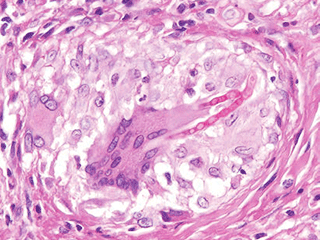Gene linked to deadly runaway fungal infection

For most people, a fungal infection like athlete's foot means a simple trip to the drugstore and a reminder to bring shower shoes to the gym. But in very rare cases, fungal infections can spread below the skin's surface and onto the lymph nodes, bones, digestive tract or even the brain. Researchers from The Rockefeller University and Necker Medical School in Paris have now discovered a genetic deficiency that allows the fungus to spread in this way, a condition called deep dermatophytosis. Their work suggests why treatments for fungal infection sometimes fail, and it gives weight to a genetic theory of infectious diseases, which proposes that a single genetic defect can cause an otherwise healthy person to become severely ill from a minor infection—be it viral, bacterial or fungal.
Jean-Laurent Casanova, head of the Laboratory of Human Genetics of Infectious Diseases, and colleagues examined the genomes of 17 people who had deep dermatophytosis but were otherwise healthy—their immune systems were working well and should have been able to fight off infection. The researchers focused on a particular gene, CARD9, because previous studies of other fungal infections had found a defect on the gene to be the cause. After sequencing the patients' genomes, CARD9 was indeed found to be deficient in all of them.
"Our research showed that CARD9 deficiency is the genetic cause of deep dermatophytosis," says Anne Puel, senior scientist at the lab's Necker division. "The primary infection was most often in childhood, when the patients showed recurrent skin or scalp ringworm, and nail infections. Due to their genetic defect and their resulting impaired immune response, the patients could not adequately fight the fungi. So instead of the germs being cleared from the body, they progressively spread until, in adulthood, the infection manifested in other body regions, which proved deadly in some cases."
The research, published this week in the New England Journal of Medicine, is the latest evidence that genetics play an important role in an individual's ability to overcome infectious diseases.
"As we discover more of these single-gene, inborn immune system defects, we can give susceptible individuals with a family history of the disease a chance to prevent it, through molecular diagnosis and genetic counseling, as well as targeted treatments that restore a poor immune response," says Casanova, who is senior attending physician at the Rockefeller University Hospital.
Casanova and his team say that further research on CARD9 will examine its exact role in human anti-fungal immunity, tracing the signaling pathways in different cell types that give an individual the ability to fight off an infection.
More information: Lanternier, F. et al. Deep dermatophytosis and inherited CARD9 deficiency, New England Journal of Medicine, October 16, 2013. www.nejm.org/doi/full/10.1056/NEJMoa1208487
















